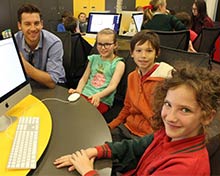Making a game of teaching

VU staff are studying a new program to see if gaming could be the classroom of the future.
Research officer Dr Kirsten Sadler and lecturer Dr Peter Thomas from Victoria University’s College of Education are studying an innovative new program. Developed by Vincent Trundle at the Australian Centre for the Moving Image (ACMI), the program uses video game creation through remote networking as a learning tool.

Through Games Net, primary and secondary students throughout Melbourne and regional Victoria collaborate online to produce their own video games. Working with industry mentors and in teams, the students develop and use contemporary communication and project co-ordination skills.
“This may well be a new pedagogy,” says Dr Thomas. “Students are already engaged and connected. It could be a great way of doing education.”
Students, ranging in age from seven to 15, work online in groups of four with an industry mentor. Each group has students of varying ages and locations.
The students meet using Zoom video conferencing program and code using Scratch or GameMaker and various other graphics and audio software.
“The students may meet physically only once,” says Dr Thomas.
ACMI Digital Education Producer, and creator of the Games Net program, Vincent Trundle, is excited by the deep level of commitment of all who are involved. He notes that, “each group works collaboratively to plan and code its game, then creates the artwork, graphics and audio. They will present their final game at ACMI’s Games Net Showcase in December.”
“Games Net engages students in all the STEAM subjects – science, technology, engineering, arts and maths,” says Dr Thomas.
He believes this way of learning could be a world-first. “Meeting online is uncommon; working together in multi-age groups is uncommon; and the remoteness is uncommon,” he says.
The pilot was held in 2015. Games Net is funded as part of the Victorian Government Strategic Partnerships Program through the Department of Education and Training through to the end of 2017.
Contact
For more information, contact Dr Peter Thomas or Dr Kirsten Sadler.



